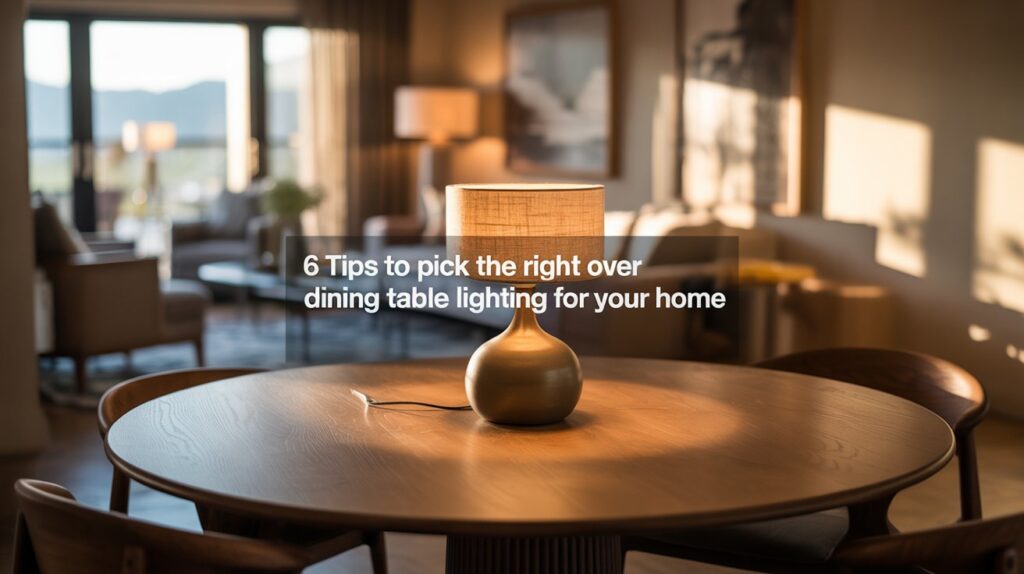The right lighting above your dining table sets the tone for gatherings, conversations, and memorable moments. Whether you’re aiming for a cozy dinner for two or hosting a lively dinner party, choosing the perfect lighting fixture is essential for the aesthetics and functionality of your dining space. Things like matching your decor’s style play a vital role in crafting a space that feels inviting. This guide discusses the key considerations for choosing over table lighting.
1. Consider the Style and Theme of Your Dining Space
While going through various over dining table lighting ideas, ensure that the one you choose should match the fixture to the overall style of the dining area. A rustic farmhouse setting benefits from weathered wood or lantern-style pendants, while modern interiors may lean toward sleek matte black or linear LED fixtures. Coastal spaces find warmth in rattan or Capiz shell designs, and romantic settings thrive under crystal chandeliers or candle-style lights. Aligning the fixture with existing decor elements creates a unified look that feels intentional rather than cluttered.
2. Choose the Right Fixture Size and Scale
Proportion plays a crucial role in selecting over-dining-table lighting. Oversized dome fixtures work well in large, open spaces but can overwhelm smaller rooms. Similarly, narrow or minimalist fixtures might disappear above a long rectangular table. Measuring the table’s width and considering ceiling height helps determine appropriate scale. Fixtures should be wide enough to visually anchor the table without extending too far beyond its edges.
3. Prioritize Proper Lighting Height and Placement
Correct positioning ensures functionality and visual appeal. Hanging a fixture too high results in insufficient illumination, while placing it too low can obstruct sightlines and create glare. As a general rule, the bottom of the fixture should sit between 30 and 36 inches above the tabletop. Adjustable suspension systems allow customization based on ceiling height and table size. For elongated tables, multiple pendants spaced evenly provide even lighting coverage.
4. Opt for Materials That Complement Your Decor
Material choice significantly influences how well a fixture integrates into the space. Wood tones echo natural furniture finishes, while metals like brass or matte black add contrast or continuity depending on surrounding hardware. Glass, linen, and Capiz shells offer softness, whereas wrought iron brings structure and definition. Selecting materials that reflect or enhance existing textures and finishes strengthens the overall design cohesion.
5. Balance Multiple Light Fixtures with Intention
Using multiple pendants or chandeliers above a dining table adds visual interest when arranged thoughtfully. Odd-numbered groupings tend to feel more balanced and dynamic, especially when spaced evenly. Varying heights slightly introduces dimension without creating chaos. Consistency in finish and shape across multiple fixtures maintains unity, even when their sizes differ. Overcrowding disrupts the sense of space, so spacing and symmetry must align with the table’s dimensions.
6. Layer Lighting for Function and Ambiance
Relying solely on overhead lighting limits flexibility. Combining ambient, task, and accent lighting allows for mood adjustment throughout the day. Wall sconces, recessed ones, or buffet lamps provide supplementary glow and depth. Dimmer switches further enhance adaptability, enabling shifts from bright, functional lights to softer, intimate settings. Layering ensures the space remains versatile for different occasions.
Choosing the right over-dining-table lighting involves going through various over dining table lighting ideas before selecting a visually appealing fixture. It requires careful evaluation of style, size, placement, material, and layering strategies to ensure the final choice enhances form and function. By aligning the fixture with the room’s existing elements and prioritizing proportion and balance, homeowners can create a cohesive, inviting dining environment.

